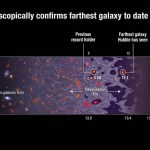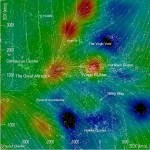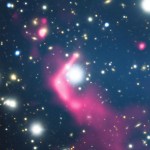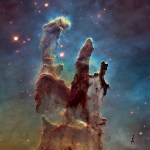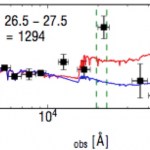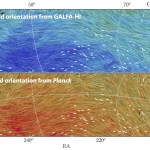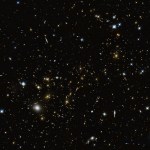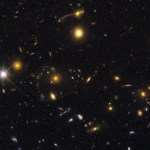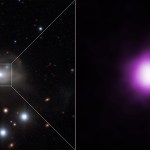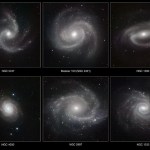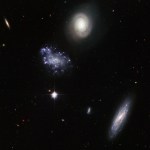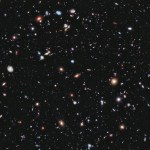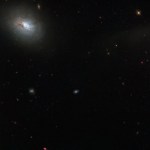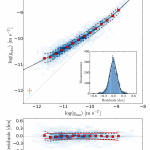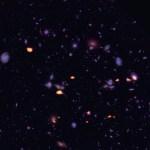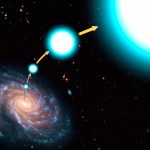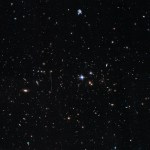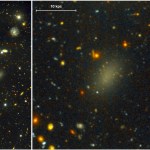Galaxies
"For the first time we can learn about individual stars from near the beginning of time. There are surely many more out there." -Neil Gehrels
We’ve come incredibly far in our quest to learn how the Universe came to be the way it is today. We can see out in space for tens of billions of light years, to galaxies as they were when the Universe was only a few percent of its present age. We can see how galaxies evolve, merge and the stars inside change. And we can see to even before that, when no stars or galaxies existed at all.
The farthest galaxy known to date, which was confirmed by Hubble,…
"For the first time, astronomers have outlined and named the network of galaxies that includes the Milky Way, adding a line to our cosmic address and further defining our place in the universe." -Douglas Quenqua
There’s been a longstanding puzzle in astrophysics that’s finally coming to a head. For nearly a century, we’ve known that our Universe is expanding, and that the distance to a galaxy determines its average apparent recessional speed from us. But on top of that is an additional motion -- a peculiar velocity -- caused by the local gravitational field of the Universe.
A two-dimensional…
"Speculating and predicting what lies beyond the boundary is fascinating. Finding out is even more fascinating." -Wallace H. Tucker
When two galaxy clusters collide, there are a slew of cosmic certainties you can bet on: all the galaxies will miss one another, the intracluster gases will collide and heat up, and X-rays will be emitted. But on rare occasion, radio emission can be found, too. Which is a puzzle, since that requires electrons to gain an extra factor of 1,000,000 in energy! How can that happen?
The most energetic shock can be clearly seen around one of the galaxies, well-offset…
“The history of astronomy is a history of receding horizons.” -Edwin Hubble
Over its more than 25 year lifetime, the Hubble Space Telescope has shown us what the Universe truly looks like. It’s done so in a myriad of ways, from planets to stars – dying and forming – to galaxies to gravity’s effects to the deepest abysses of blackness of all. Nothing in space is the same as it was before humanity knew Hubble. Yet even the camera most responsible for our iconic images, WFPC2, isn’t the end of the story.
The gravitationally interacting system, Arp 147. Image credit: Arp 147, via NASA, ESA, and…
"The discovery that young galaxies are so unexpectedly bright--if you look for this distinctive green light--will dramatically change and improve the way that we study Galaxy formation throughout the history of the Universe." -Matthew Malkan
Galaxies come in many different colors today: white, blue or red, mostly, depending on the populations of stars inside. But in a very rare set of circumstances, there can be green emissions as well, due mostly to the emission lines of doubly-ionized oxygen. The problem is we only see these in extraordinarily hot regions of the Universe, where ultra-hot…
"Every philosophy also conceals a philosophy; every opinion is also a hideout, every word also a mask." -Friedrich Nietzsche
If you want to see all the way back to the Big Bang -- to the cosmic microwave background -- that means looking back through billions of light years worth of space. While individual point sources like stars and distant galaxies are relatively easy to exclude, the most catastrophic interfering factor is the Milky Way itself. Gas, dust, spinning molecules, magnetic fields, stars and more are all known to play a role.
The alignment of neutral hydrogen (white lines) with…
“You may hate gravity, but gravity doesn’t care.” –Clayton Christensen
If all we had were galactic rotation curves -- like those measured by Vera Rubin -- we would know that something was wrong with our picture of the Universe, but we wouldn’t know how. Two equally good explanations, that there was either a flaw in the law of gravity or there was the existence of some unseen mass, could account for what we saw. But observations of galaxy clusters point to dark matter in a dramatic fashion.
The Coma cluster of galaxies, whose galaxies move far too quickly to be accounted for by gravitation…
"Science progresses best when observations force us to alter our preconceptions." -Vera Rubin
When you look at a galaxy in the night sky, it’s easy to imagine that it’s just a system of masses like our Solar System, except on a larger scale. Instead of a single, central mass, you have many stars responsible for the galaxy’s gravitational pull. The stars revolving around the galactic center feel the tug from all the other stars and orbit accordingly, with the inner stars orbiting quickly and the outermost ones -- the ones most distant from the gravitational sources -- orbiting more slowly,…
“Deep into that darkness peering, long I stood there, wondering, fearing, doubting, dreaming dreams no mortal ever dared to dream before.” -Edgar Allan Poe
No matter where you look in the night sky, a powerful enough telescope appears to reveal points of light. Even if you find a region with no stars in the Milky Way, you’re likely to find thousands of galaxies in the deep sky beyond, as the Hubble Deep Field and successor images demonstrated. However, it wasn’t until 2010 and the WFC3 that we were able to get deep, wide-field views simultaneously.
A ground-based view of the region of sky…
"I'll never, ever be full. I'll always be hungry. Obviously, I'm not talking about food." -Dwayne 'The Rock' Johnson
Only a very small percentage of galaxies have active supermassive black holes. While the black holes themselves are common, they only rarely feed, gaining a huge influx of matter to accelerate and send jets and other emission out. When a galaxy does become active, they can appear in any number of interesting manifestations, dependent on their orientation relative to us.
The unified model of AGNs/Active Galactic Nuclei. Image credit: Robert Antonucci, aka Ski, of http://web.…
"The evidence at present available points strongly to the conclusion that the spirals are individual galaxies, or island universes, comparable with our own galaxy in dimension and in number of component units." -Heber Curtis, 1920
In many different areas of life, we settle disagreements by popular vote. But in science, we know better; regardless of whether people accept the conclusions or not, the Universe simply is the way it is, and it’s up to us to listen to the evidence to uncover scientific truths. It often happens, however, that everyone can agree on the pieces of evidence, yet disagree…
"In order for the light to shine so brightly, the darkness must be present." -Francis Bacon
If you had previously thought the Universe contained a certain amount of stuff, like stars, galaxies and matter, then you might think that learning it had ten times as many galaxies might mean it had ten times as much matter. And if this were the case for matter like us, made of protons, neutrons and electrons, perhaps there wouldn’t be a need for something like dark matter, after all.
The different shapes, structures and morphologies of some of the galaxies in Hickson Compact Group 59 show evidence…
“Our posturings, our imagined self-importance, the delusion that we have some privileged position in the Universe, are challenged by this point of pale light. Our planet is a lonely speck in the great enveloping cosmic dark. In our obscurity, in all this vastness, there is no hint that help will come from elsewhere to save us from ourselves.” -Carl Sagan
How many galaxies are there in the observable Universe? If you had asked this question a century ago, the answer could have been anywhere from one to infinity. If you asked fifty years ago, we’d know the number was finite, since we knew about…
"They most likely form as subsystems within looser associations and evolve by gravitational processes. Strong galaxy interactions result and merging is expected to lead to the ultimate demise of the group. Compact groups are surprisingly numerous, and may play a significant role in galaxy evolution." -Paul Hickson
With hundreds of billions of galaxies in an observable Universe nearly 100 billion light years across, it should come as no surprise that most galaxies are separated by millions of light years from their next-nearest neighbor. Yet even outside of dense galaxy clusters, large numbers…
"Nothing in the standard cosmological model predicts this, and it is almost impossible to imagine how that model could be modified to explain it, without discarding the dark matter hypothesis completely." -David Merritt
Dark matter is a hugely successful theory for explaining a whole slew of observations about the Universe. Just by adding this one ingredient to the mix, we can successfully simulate and reproduce the large-scale structure, CMB fluctuations, galaxy clustering and cluster collision properties observed in our Universe. Without dark matter, there's no other way known to make…
"We conducted the first fully blind, three-dimensional search for cool gas in the early universe. Through this, we discovered a population of galaxies that is not clearly evident in any other deep surveys of the sky." -Chris Carilli
The Hubble Ultra Deep Field and its successor images represent humanity’s deepest views of the stars in our Universe. But there’s more to the Universe than just stars; even the normal matter in the Universe is more commonly present in the forms of gas and plasma than in stars. Hubble can never image those so far away, since their wavelengths are too long. But the…
“Mapping out the elements in a star is like reading its DNA. We’re using those DNA readings to decode the history of the Milky Way from the stars that we can observe today.” -Steven Majewski
Most of the stars in our Milky Way have long lives ahead of them, with dozens or even hundreds of orbits around the entire galaxy to come over their lifetimes. With hundreds of billions of stars involved in this cosmic dance, it stands to reason that on occasion, another nearby star will either gravitationally or cataclysmically (e.g., from a supernova) kick such a star to incredible velocities, perhaps…
“These galaxies are among the most massive galaxies in the universe and are believed to have rapidly formed their stars a long time ago. However, how these galaxies formed and why have they stopped forming new stars remain mysteries.” -Tao Wang, lead author on this new study
There was once a time early on in the Universe where there were no stars, no galaxies and no clusters of galaxies at all. While stars and galaxies form very early on, after only tens or hundreds of millions of years, it takes billions of years for the first clusters to form. Yet even if we were to look back into the…
"Motions of the stars tell you how much matter there is. They don’t care what form the matter is, they just tell you that it’s there." -Pieter van Dokkum
Everything in the Universe was born with the same ratios of dark matter to normal matter: approximately 5-to-1. It shows up in everything from the cosmic microwave background to galaxy clustering to internal motions of spiral and elliptical galaxies, including the Milky Way.
From simulations and inferred maps, dark matter (blue) may form some clumps, but overall exists in a massive, diffuse halo around the luminous, disk-like part of…
"This suggests a lack of Cepheids in the inner 2.5 kpc region of the Galactic disc except the [Nuclear Stellar Disc]." -N. Matsunaga et al.
If you want to find where all the young stars in a galaxy are, you look for the densest regions of gas and dust: the locations where new stars and star forming regions are most likely to occur. In the Milky Way, like all spirals, we expect this to be in the galactic plane, along the spiral arms, and in the innermost region of the disk and bulge.
A multiwavelength view of the very center of the Milky Way galaxy, including X-ray, visible, infrared and…
